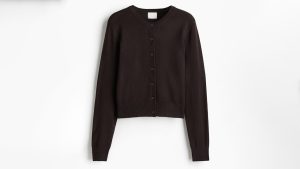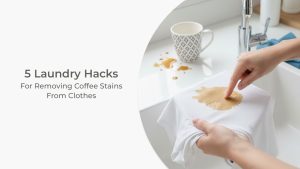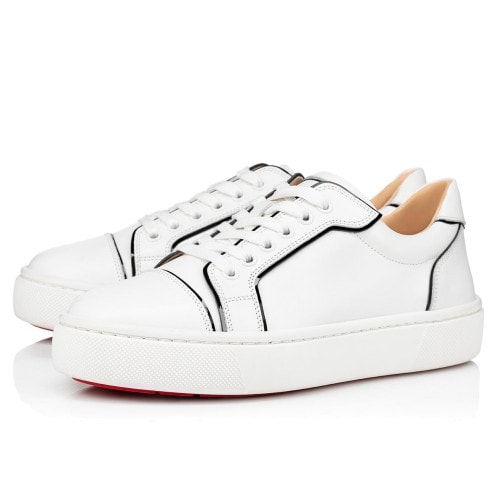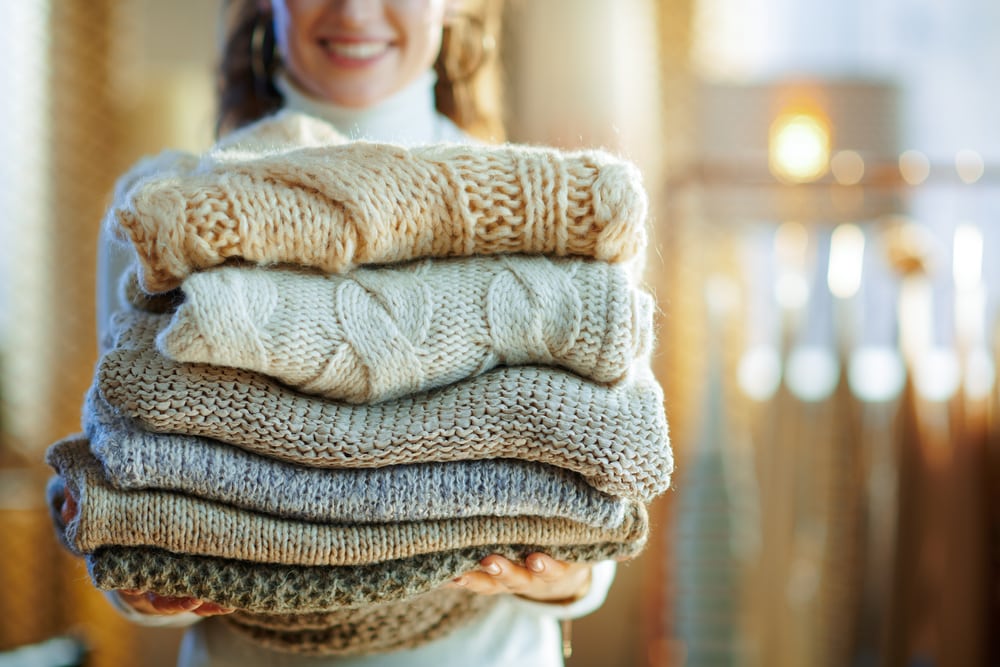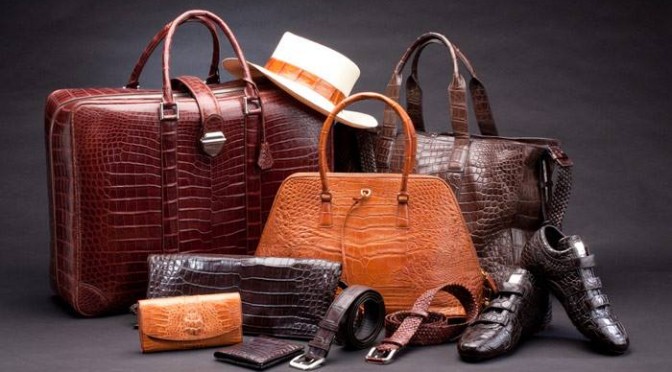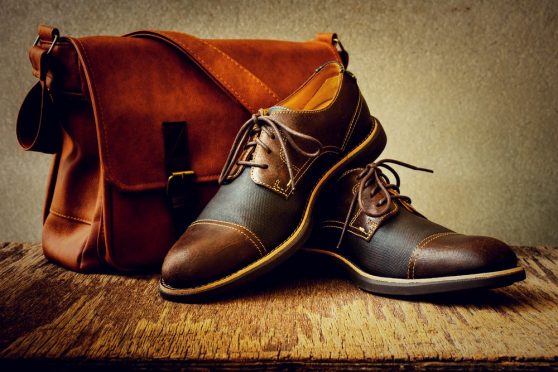In winters, men also get worried about their...
Read More- Blogs
- Dry Cleaning
- How to Remove Ink Stains From Clothes
How To Remove Ink Stains From Clothes
- Amrita Singh
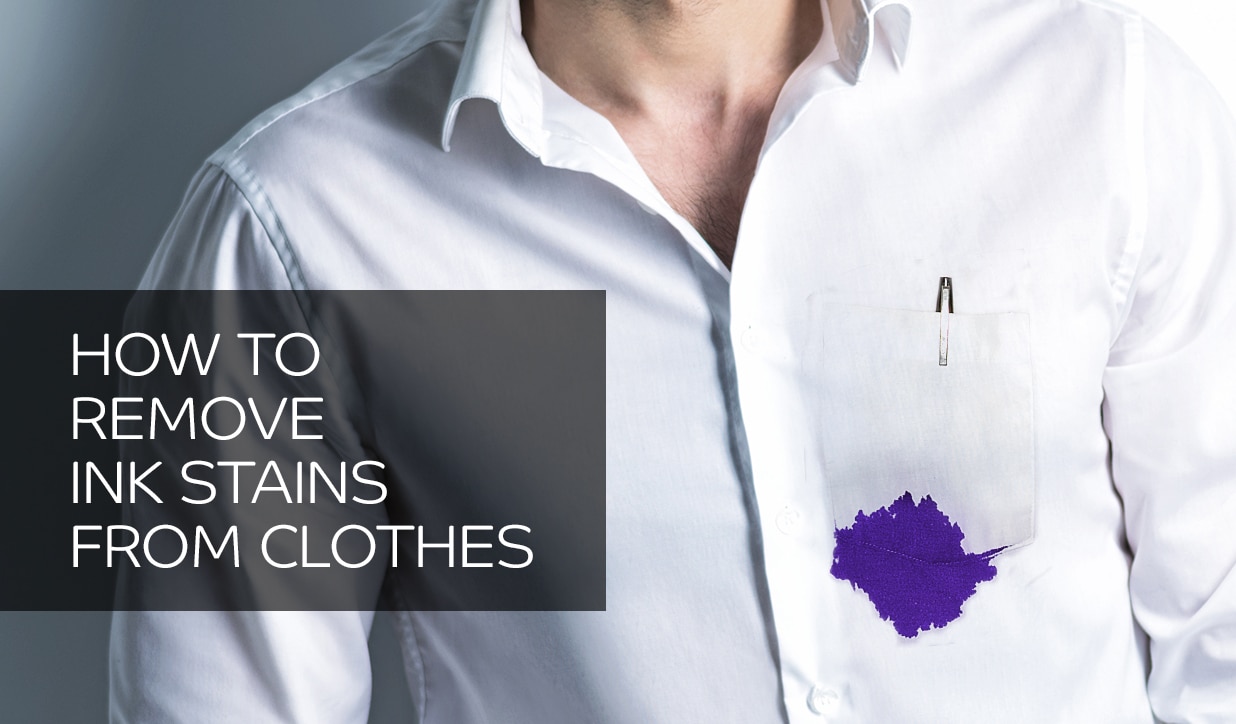
Table of Contents
Do you feel an ink stain can ruin a garment forever? That’s not true. Because just like other common stains you can remove ink stains from clothes as well. In this article, we will tell you how to do it.
We will share some common products that you can use to remove ink stains. But before that, you should know about different types of inks so that you can determine the stain and use the appropriate product on it.
We can differentiate inks into three categories depending on their base:
- Water-based ink: It is used in gel pens, rollerball pens, fountain pens, washable markers, etc.
- Oil-based ink: It is used in ball-point pens, felt-tip pens, etc.
- Alcohol-based ink: It is used in permanent markers.
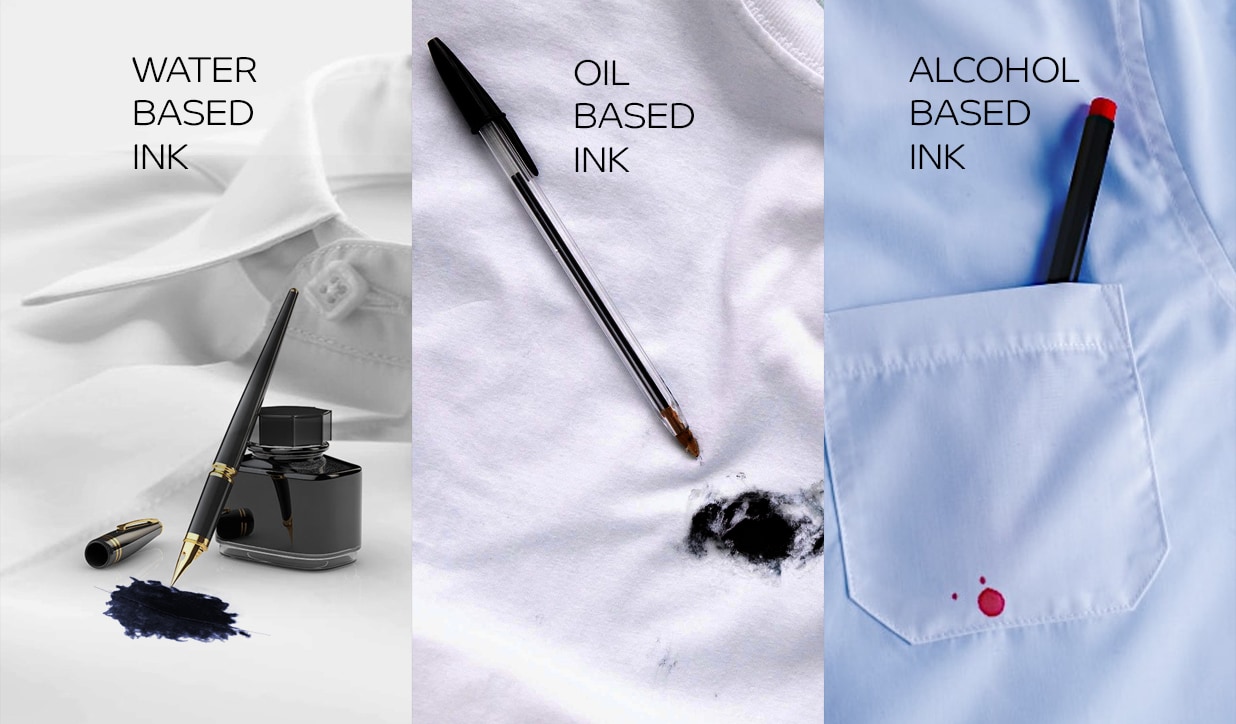
It is easy to remove water-based ink. Sometimes these stains can be removed by treating the stain with regular detergents like Surf excel, Ariel, etc. Laundry additives like Vanish also work on water-based ink stains. However, oil and alcohol-based stains are tough to remove.
The toughness of the stain also depends on how intensely the fabric absorbs ink. Some fabrics like cotton and wool absorb ink faster. Whereas, some fabrics like polyester, rayon, acetate, etc. absorb ink slowly.
Now, let’s move ahead to see stain removers.
Common Products To Remove Ink Stains From Clothes
Determine what type of ink has stained your garment and then use a suitable remover mentioned below. In case you cannot determine the type of ink, use stain removers which are safe to use on oil-based stains. Because water-based ink can be easily removed using any of these stain removers. However, you will see no difference in applying stain remover that only works for water-based ink like milk on an oily stain. Hence, it will be a waste of time, effort and product as well.
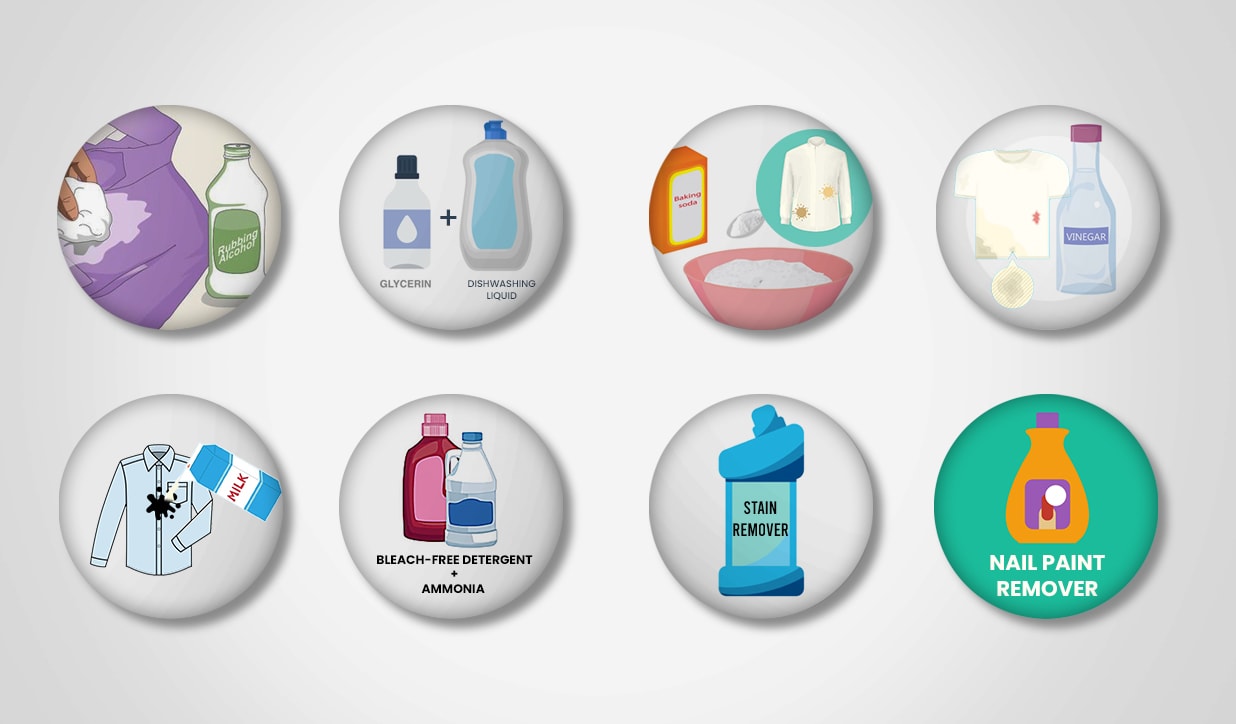
Pro Tip: Use rubbing alcohol, bleach-free detergent + ammonia and commercial stain removers on permanent marker stain (alcohol-based) other stain removers might not be very effective on it).
Rubbing Alcohol
One thing that should be your first choice for not only ink stains but all other oil-based stains is ethanol. But, where do you find ethanol? You might be already using it. Ethanol is found in hand sanitizer, hairspray and rubbing alcohol. This is why you will see people recommending hairsprays & sanitizers for stain removal.
While other products don’t have enough quantity of ethanol to remove ink stains, rubbing alcohol contains enough of it to wipe away ink stains. You can easily purchase it from pharmacy stores. Rubbing alcohol can remove of ink stains of all kinds. However, it is best suited for tough stains (oil and alcohol-based ink). We do not recommend using rubbing alcohol on silk, rayon and acetate.
Glycerin + Dish wash liquid
Glycerin is a common household product. But, if you don’t have it at home, you can purchase it from any pharmacy store or online easily. Next, you can use any normal dishwashing liquid like Vim. Mix 1 tablespoon (approximately 15 ml) and 1 teaspoon (approximately 5 ml) of liquid detergent together to remove ink stains. You can use this mixture on all types of ink stains and fabrics.
Baking Soda
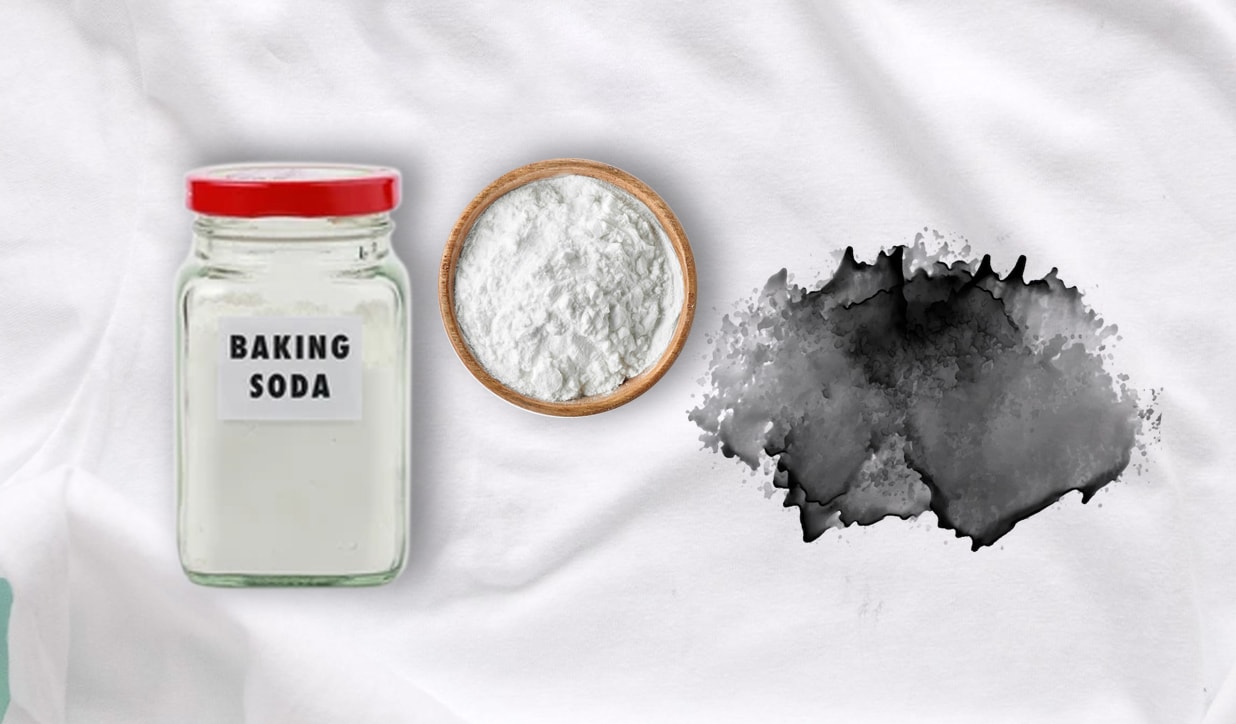
Baking soda is yet again a common household item. It is easily available in retail stores. You can use it on all types of ink stains. We do not recommend using it on natural fibres such as silk and wool as baking soda has a very high PH level which can fade the organic fibres. You will have to add water to baking soda to remove ink stains. Ideally, you should add 2 tablespoons of water to 1 tablespoon of baking soda and make a loose paste. You can increase the quantity depending on the stained area. The key is to keep the ratio 2:1 and cover the whole stain with the paste.
In case you don’t have time to try home remedies, you can try Tumbledry for stain removal too.
White Vinegar + Cornstarch
Vinegar and cornstarch are two common products that you can easily find in your nearest retail stores. Mix 2 tablespoons of cornstarch and 3 tablespoons of white vinegar and use this paste as a stain remover for water-based ink stains. It will not be very effective on oil and alcohol-based ink stains. Cornstarch does not harm the fibres of a fabric. Some people think vinegar can ruin fabric, however, that is not the case. The acetic acid found in distilled white vinegar is so mild that it does not harm washable fabrics.
Milk
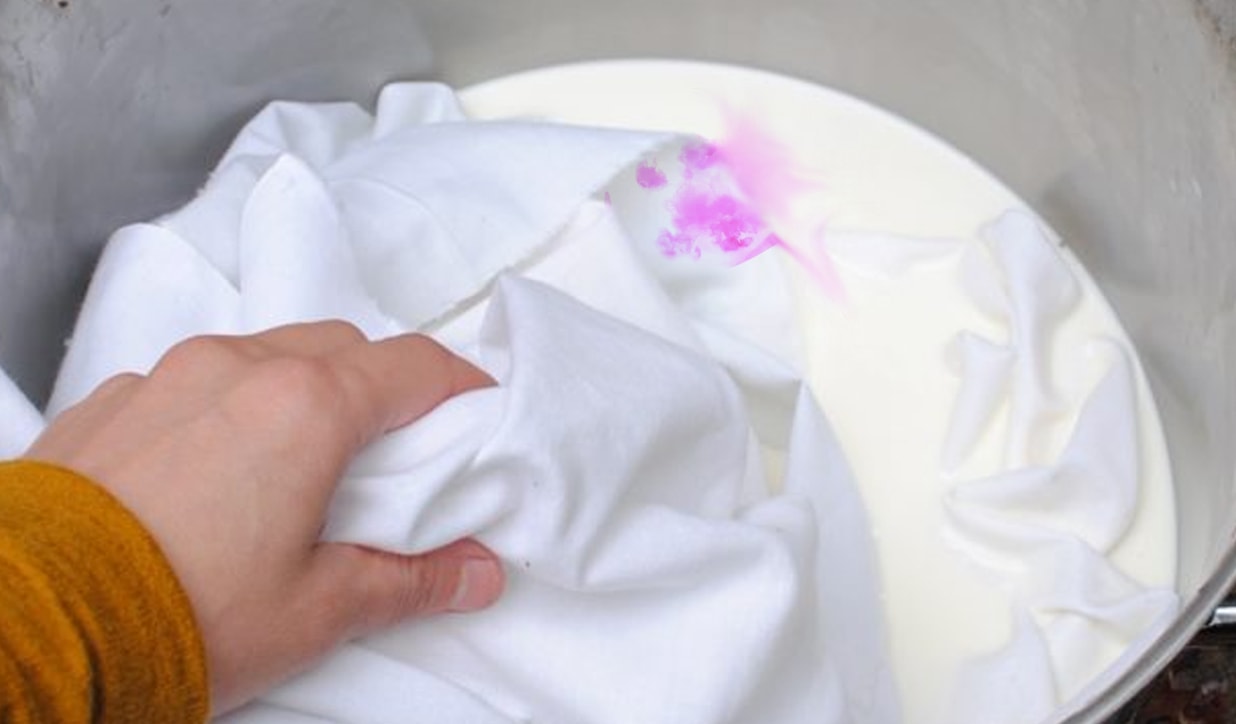
Did you ever think milk can remove ink stains? Yes, it can. Milk can dissolve the ink stains and remove them completely. However, it only works on water-based ink. When it comes to fabrics, you can soak any type of fabric in milk overnight. It will not harm the fibres of a garment.
Nail Paint Remover
Any acetone-based nail paint remover like Lakme can help you in removing ink stains. You can use it on oil-based ink stains. However, be careful while doing spot tests, because every fabric might not tolerate the harshness of a nail paint remover. We do not recommend using it on delicate or natural fibres like silk, wool, velvet etc.
Bleach-free Detergent + Ammonia
Ammonium hydroxide or ammonia can remove ink stains as it is used as a cleaning agent. You can easily purchase it from pharmacy stores. It is effective for oil-based ink stains. Avoid using ammonia on delicate fabrics like wool, silk, velvet, etc.
It is not suggested to mix ammonia and bleach. So, you can use any bleach-free regular detergent like Surf Excel or Tide. Make sure you check the ingredients while buying a detergent. Words like oxy clean, and oxy bright clearly indicate that the product contains oxy bleach and you have to avoid bleach.
Commercial Stain Remover
There are a lot of commercial stain removers available on the market. You can use any of them to remove ink stains from clothes. Some popular stain removers are Tide to Go Pen, Tetraclean stain remover, Dr Beckmann Stain Devils Pen, etc. Generally, these stain remover contains chemicals which can deal with all types of ink stains. However, we recommend you to see the label care of the product to see whether it should be applied on all ink stains and fabrics or not.
The next thing you need to know is how to remove ink stains from clothes using these stain removers.
Steps To Remove Ink Stain From Clothes
Step 1: Collect everything you need for ink stain removal
Keep everything you need in one place so that you do not have to run around the house while removing ink stains. It will save you from unnecessary hassle. Here are the things you will need:
- 3-4 White microfiber clothes
- 3-4 White paper towels
- Old Toothbrush
- Bowl or Container
- Laundry Detergent
- Rubbing Alcohol
- Glycerin
- Dishwash Liquid
- Baking Soda
- Vinegar
- Cornstarch
- Commercial Laundry Detergent
Out of all the stain removers mentioned above in the list, you just have to pick the ones you are going to use.
Pro tip: Always use a white towel or cloth to treat the stain to ensure that the colour of such clothes does not bleed or transfer to the garment.
Step 2: Blot the ink stain (Only for fresh stains)
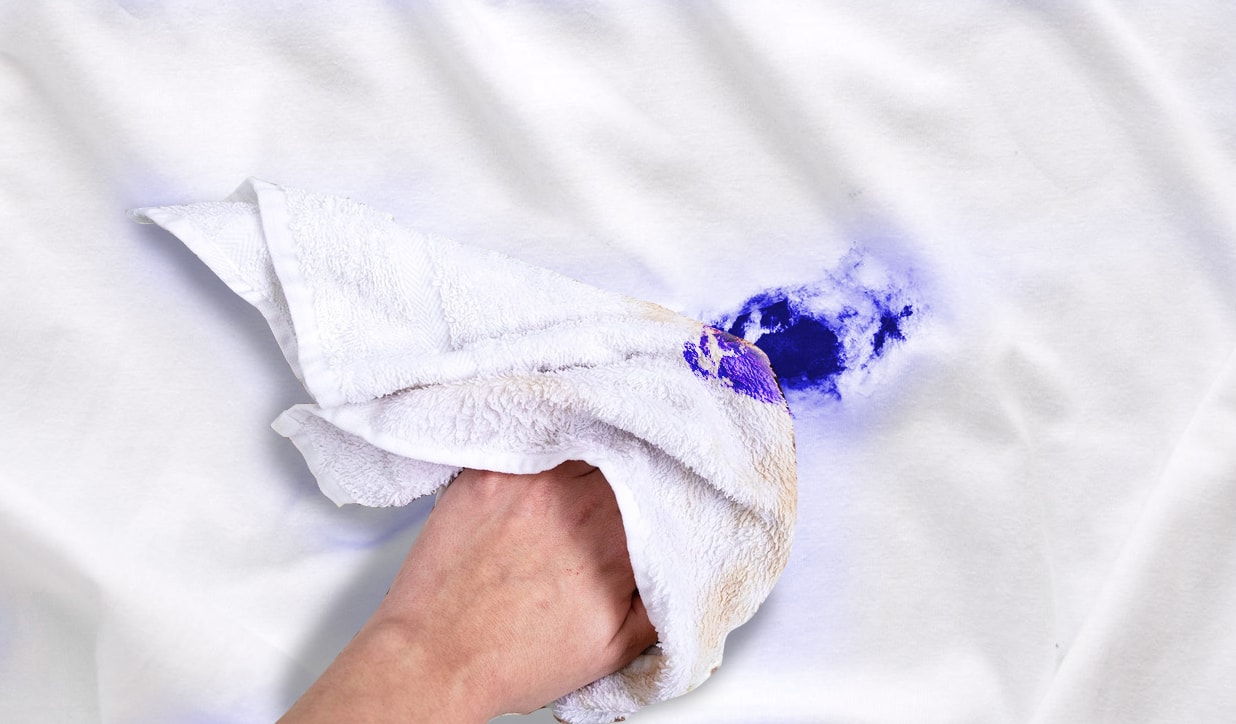
If the stain is still fresh, try to absorb the ink on another cloth by blotting. Take a clean towel and place it underneath the stained area. Take a white cloth and start blotting the stain. Do not rub the stain harshly as it will make it settle strongly in the fabric. You have to blot until the ink stops lifting up on the cloth. Once the cloth has absorbed all the excess ink you can apply the stain remover.
Pro tip: While blotting the stain or applying a stain remover to sleeves, trousers, or any area which cannot be laid directly on a flat surface, place a towel between the inner and outer sides of the garment. This will prevent the stain from transferring to the other side of the garment.
Step 3: Do a patch test
Before applying stain remover directly onto the stain you should always do a patch test. Apply the stain remover on an area which is not clearly visible such as inside hems. Wait for at least 15-20 minutes and check how the fabric reacts to the stain remover. If it does not cause any harm, then go ahead with stain removal.
We do not recommend using these stain removers on garments labelled as “dry clean” or “dry clean only”. They might not tolerate some of the ingredients of stain removers. It is better to send such clothes to dry cleaners. They have specific pro-fabric stain removers which can get rid of the stains without damaging the fabrics. In case you are using a commercial stain remover or a home dry-cleaning kit, you should still check the label and do a spot test.
Step 4: Apply the stain remover
We have explained how to remove ink stains from clothes using different stain removers in detail.
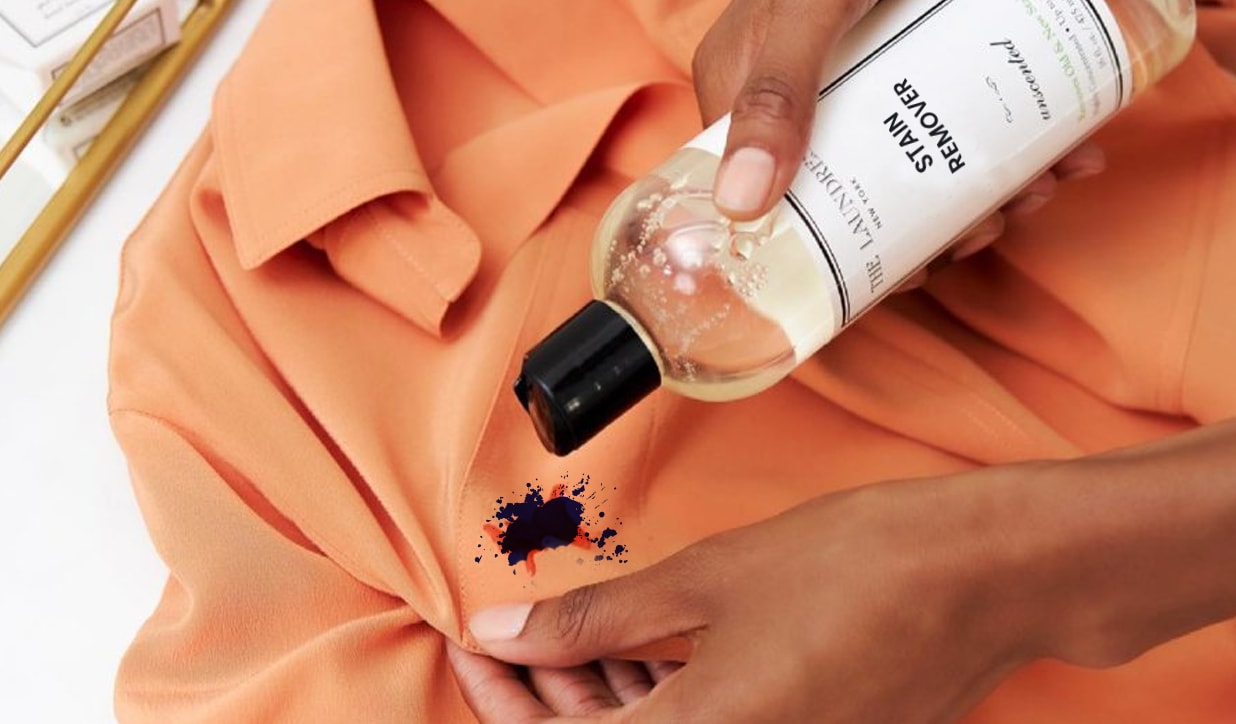
Caution: If the microfiber cloth or paper towel that you are using to blot/dab the stain has soaked up excess ink, change it. Use another cloth or towel to prevent the excess ink from spreading to other areas of the garment.
Rubbing Alcohol
Dip a clean cloth in rubbing alcohol. Start dabbing it onto the stain. Once the stained area is damp, leave it for 5 minutes. Then blot the stain with another clean cloth or paper towel pressing down on the towel underneath. Do this until the stain goes away or lightens. Repeat the process if necessary.
Glycerin + Dish wash liquid
Take a clean cloth, dip it in the mixture of glycerine and dish wash. Start dabbing at one side of the stain. Dab until the stain stops lifting up on the cloth. Then flip the garment and repeat the same process on the backside of the stain. Leave the garment as it is for 5 minutes. Apply some glycerin to cover the stained area and flush it with water to get rid of residue. Repeat the process if necessary.
Baking Soda
Take the paste of baking soda and water. Apply it onto the ink stain with the help of a cotton ball and dab it. Dab until you see the stain lifting up. Stop when the stain goes away or it is no longer lifting up on the cotton ball. Use a microfiber clean cloth or paper towel to wipe off the residue. Repeat the process if necessary.
White Vinegar + Cornstarch
Pour distilled white vinegar on the ink stain. Then, apply the paste of vinegar and cornstarch to the stain and rub it gently. Let the paste dry completely and then launder the garment. Repeat if necessary.
Milk
Take a shallow bowl or a container in which you can soak the stained area. Fill it with enough milk to submerge the stained area of a garment. Soak the garment (only stained area) in the milk and leave it overnight. The enzymes of milk will slowly dissolve the water-based ink and your garment will be stain-free.
Nail Paint Remover
This method may require a lot of product (nail paint remover). There are no certain measurements in which you should apply the remover. The key is to dampen the stain with nail paint remover. You can pour it directly from the bottle. Start rubbing gently immediately after the stained area gets damp. Initially, you will see the stain spreading onto a larger area. Don’t panic. Keep repeating the process. Generally, after 5-6 attempts the stain breaks down and goes away.
Bleach-free Detergent + Ammonia
Fill a bucket with hot water and put a tablespoon of your regular bleach-free laundry detergent. Add 4-5 drops of ammonia and stir it. Now, soak the garment in the bucket. Rub the stain gently and leave it in the bucket for 30-60 minutes. Generally, the stain goes away. However, if the stain has lightened and not vanished, you can let it soak overnight. Rub the stain 2-3 times in between intervals of 2-3 hours.
Commercial stain remover
In general, you should pour a few drops (liquid stain remover) or 1 teaspoon mixed with a few drops of water (powder stain remover) onto the stain. Blot with a clean microfiber cloth until it lightens or goes away. However, different stain removers may have different ways of usage. You can also use stain remover pens like Tide To Go pen. Hence, we recommend you use the commercial stain removers as per the instructions mentioned on their packaging.
Removing toughest ink stains is super easy with Tumbledry!
Step 5: Launder and air-dry the garment as usual
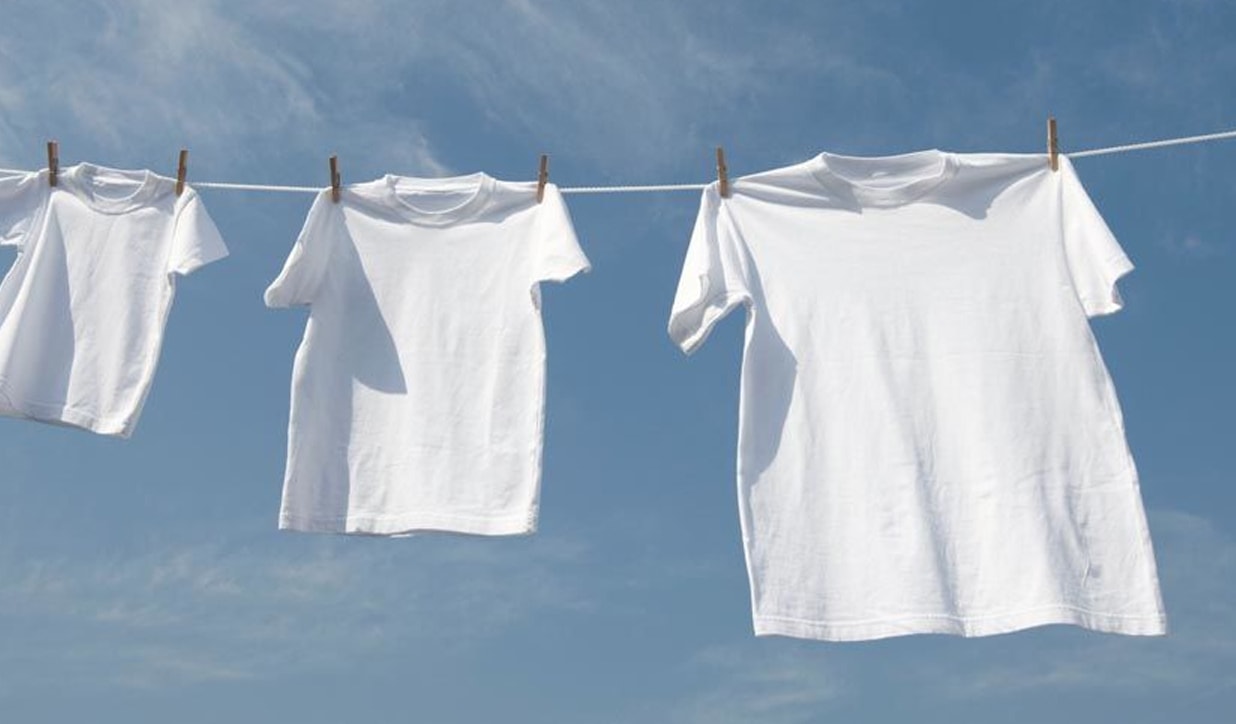
Once the stain is gone or lightened to a great extent, rinse the garment with cool water to get rid of the stain remover. Rub a pinch of your regular laundry detergent (2-3 drops if you are using a liquid detergent). Then put it in your washer. Run the machine on a gentle cycle or launder as usual. In any case, it is better to air-dry or line dry clothes. However, if you prefer drying clothes in the machine, do it only if the stain has completely gone. The dryer will make the stain residue set strongly. While you can get rid of such residue easily after repeating the process of stain removal, drying in the machine will make it very hard.
Key Takeaway
It is best to treat ink stains when they are still fresh. So, if you have spotted it early, blot the fresh stain to prevent the ink from setting strongly inside the fabric. There are three types of ink stains: water, ink and based stains. After blotting the fresh stain, you should determine which type of stain you have on the garment. Choose a suitable stain remover on the basis of stain and fabric. If you are not sure about the type of stain you can go for the stain removers used on oil-based ink. And, if the garment is not washable, it is better to send it to the dry cleaners.
Application of different stain removers are mentioned separately in the blog, you can follow that with washable fabrics. Once the stain is gone, you just have to launder and air-dry the garment as usual.
Frequently asked questions on removing ink stains
You can use Glycerin to remove very old ink stains from clothes. Apply it as explained above in the article and wash the stained area with your regular laundry detergent. Glycerin saturates the stain and lifts it up. This helps the detergent to easily clean the stain.
Hairspray contains 25-50 per cent alcohol which might work on ink stains. You can try using it on a stain. In case it fails, go for rubbing alcohol which is a more concentrated option. It can help you with tough ink stains.
Yes, you can use hand sanitiser to remove the ink stains. However, just like hair spray, it is the alcohol in hand sanitiser that works on a stain. Alcohol-based sanitisers might contain around 60% alcohol. And it might not be enough to completely remove a stain. It is better to use a concentrated option which is rubbing alcohol to remove ink stains effectively.
Vinegar is a popular cleaning agent, you can try using vinegar alone or make a paste of vinegar and cornstarch on water-based ink stains. However, it is not very effective on a permanent marker stain (alcohol-based stain).
Disclaimer: The opinions expressed in this article are those of the author. They do not necessarily purport to reflect the values or views of Tumbledry.
How To Find The Best Dry Cleaners In
Dry cleaning our clothes have been an important...
Read MoreHow to Choose the Best Winter Suit for
Winter suit for women have plenty of variety...
Read MoreHow to Maintain Winter Sweaters: Dos & Don’ts
Wool sweaters are among the necessities for winters....
Read MoreTraditional Dresses Of Rajasthan For Men & Women:
When it comes to best traditional dresses in...
Read MoreBest Winter Jackets For Men: Style, Warmth &
In winters, jackets for men are significant parts...
Read MoreBomber Jacket vs. Puffer Jacket: Style, Warmth &
Bomber or Puffer, both types of jackets have...
Read MoreBest Winter Wear For Women & How to
Winter wardrobes need much care and expert tips...
Read MoreBest Cardigan Sweater For Women To Style In
In winters, there are limited options to style...
Read More5 Laundry Hacks for Removing Coffee Stains From
Many people end up losing their favorite garment...
Read More








